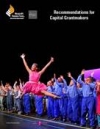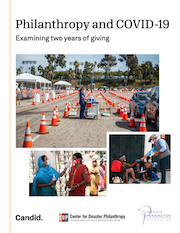Site Search
- resource provided by the Forum Network Knowledgebase.
Search Tip: Search with " " to find exact matches.
It’s well established that employee engagement, defined as a willingness to do more than the job minimally requires, drives corporate performance. This report examines one potential driver of employee engagement - corporate volunteering, defined as employer-organized opportunities for employees to support a charitable cause or otherwise make a positive social impact with their contribution of time.

Recommendations for Capital Grantmakers, is written for arts funders who are looking to make smart and impactful investments. It includes tips for planning a grantmaking strategy, making the grant match the need, and ensuring that the grant is implemented successfully. This summary highlights findings from Nonprofit Finance Fund's study of 36 capital grants made by the Kresge Foundation to arts organizations between 2010 and 2012.
Developed by Washington Regional Associations of Grantmakers' Public Education Working Group, How Do Teachers Become Great? shows that the highest level of student performance is directly linked to having high-performing teachers. High-performing teachers are products of effective professional development - and the development and teaching strategies of these educators can be replicated.
What factors should you consider if you want your grant investment to have the greatest impact on student academic success?
The Montclair Foundation has awarded $65,000 in Fall 2023 Grants to nonprofits that serve the Montclair community and beyond.
The Montclair Foundation nurtures growth in our community through support and grant giving to local nonprofits and the preservation of the historic Van Vleck House & Gardens. Grants are awarded twice annually.to a wide variety of local nonprofits that make a big impact on small budgeted organizations in the arts, family services and underserved communities in Montclair.
The Summit Foundation awarded $320,000 in grants to 19 exceptional organizations dedicated to enriching the lives of people residing in the Summit area. These grants will support a wide range of impactful programs, from health and education to the arts and community services.
The Summit Foundation supports the Summit, NJ, area by providing grants, scholarships, and donor-advised distributions to address emerging needs and make a meaningful difference in people’s lives.
The Administrative Assistant serves as a strategic partner to the CEO and essential support to the Programs Team, ensuring seamless operational excellence that enables the Foundation to maximize its impact. This role combines high-level executive support with project coordination and systems management, requiring exceptional organizational skills, discretion, and the ability to anticipate needs in a fast-paced philanthropic environment.
When Mayor Ras Baraka took office in 2014, he immediately called for an expansion of the city’s Summer Youth Employment Program.
There is a growing body of evidence that youth employment programs are a positive intervention that can reduce summer violence and incarceration and improve educational outcomes of participating youth. Just as important, they help to expose youth to career pathways early, allowing the city to integrate youth into an overall workforce development strategy. For Mayor Baraka, the call was personal — he participated in the program as a youth and remembers fondly the impact it had on his life.
The Westfield Foundation is proud to announce the allocation of $52,000 in Q3 grants, raising its total year-to-date funding to $278,000. This quarter’s grants reflect the Foundation’s ongoing dedication to improving community well-being, focusing on inclusivity, accessibility, mental health support and elder care.
“Our goal is to support all segments of our Community," said Katie Curran Darcy, Executive Director of the Westfield Foundation. "These investments in critical areas, provide children with inclusive play spaces, offer essential care for our seniors, and mental health support for our youth. We believe these projects will have a lasting impact.”
In light of the many recent executive orders and policy shifts, and the impact they’re having on our nonprofit community, the Grunin Foundation is organizing a virtual Monmouth-Ocean Roundtable of Funders (MORF) call. This will be an informal space to discuss what we’re hearing from our partners on the ground, share information about emergency funding foundations may be setting up, and highlight some potential state-wide initiatives in the works. It’s crucial that we all stay in touch, share insights, and continue supporting our partners in Monmouth & Ocean counties (and beyond). We hope you can join us!
This piece captures five key insights to guide organizations as they develop ongoing Measurement, Learning, and Evaluation plans to achieve greater social impact:
- Theory of Change amplifies your impact—helping you focus on the linkages between, and assumptions underlying, your strategies and outcomes.
- Progress toward long-term goals is observable in interim measures.
- Setting targets along the way forecasts your trajectory and provides feedback that tells you if you’re moving in the right direction.
- Impactful measurement needs to align with the rhythm of your work and provide the right data at the right times.
- The payoff of measurement is in the practice, and putting that practice to use greatly increases your odds of success.
When confronted with measurement and evaluation, some turn first to the expensive and time-consuming practice of “gold standard” experimental designs requiring comparison groups to definitively prove whether an intervention delivers the expected results. While measurements of this type are reasonable in certain situations, they are often a stretch for the real world of social innovation and are limited in their timeliness, strategic value, cultural applicability, and validity for measuring the changes sought.
You can get more for less—by deploying measurement based on social science rigor and valuing adaptability and learning. In other words, social innovation is best measured in real time and in ways that can be seamlessly woven into the rhythm of the business cycle and the daily practices of those responsible for funding, managing, and implementing social change.

